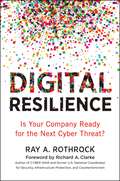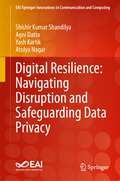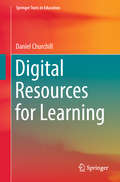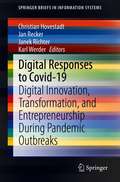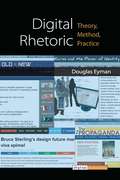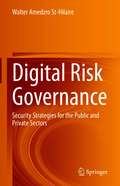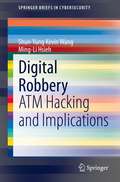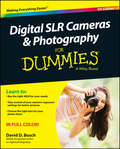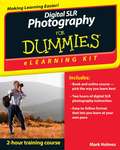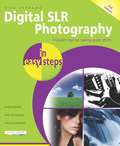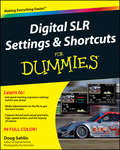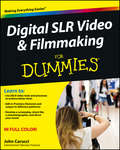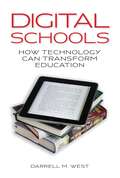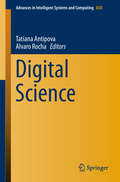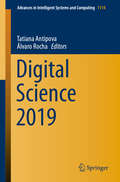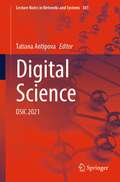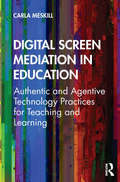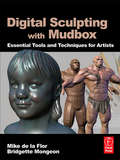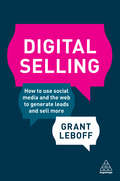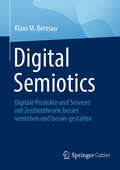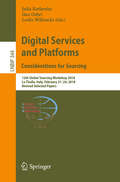- Table View
- List View
Digital Resilience: Is Your Company Ready for the Next Cyber Threat?
by Ray RothrockDon’t let your company be the next grim headline . . . Cybercrime is on the rise — and businesses large and small are at risk. For management, the question is not if you will be targeted, but when. Are you prepared? Is your enterprise actively monitoring networks, taking steps to understand and contain attacks, enabling continued operation during an incident? Do you have a recovery plan ready? Few are prepared, explains cybersecurity expert Ray Rothrock, who lays bare tactics used by hackers, vulnerabilities lurking in networks, and strategies not just for surviving attacks, but thriving even while under assault. Fascinating and highly readable, Digital Resilience opens with the infamous 2013 Target attack, which compromised the credit card information of 40 million customers. In hindsight, the hack (like most today) was preventable. This book helps businesses: Understand the threats they face • Assess the resilience of their networks against attacks • Identify and address weaknesses • Respond to exploits swiftly and effectively Data theft. Downed servers. Malware. Even human error can trigger cyber events anytime from anywhere around the globe. This powerful guide provides the resilience-building strategies you need to prevail — no matter what strikes.
Digital Resilience: Navigating Disruption and Safeguarding Data Privacy (EAI/Springer Innovations in Communication and Computing)
by Atulya Nagar Shishir Kumar Shandilya Agni Datta Yash KartikThis book offers an in-depth overview of digital resilience, defined as the ability of individuals, organizations, and societies to adapt to and counter various digital threats such as cyberattacks, data breaches, and other forms of cyber threats. Digital resilience not only enables proactive measures but also ensures fault-tolerant planning and design. The book elaborates on the necessary techniques and methods to achieve digital resilience. Key methodologies, including quantum computing, post-quantum cryptography, nature-inspired cybersecurity, zero-trust systems, zero-knowledge proofs, multi-party computation, and the emerging field of space security, are discussed in detail. The book provides insights into artificial intelligence and machine learning, examining their impact on society and organizations. It critically analyses the role of cybersecurity in businesses, emphasizing its importance for safety and economic stability. In addition, the book discusses notable cyber incidents, offering valuable insights into digital resilience. It serves as a comprehensive compilation, featuring key terms, definitions, case studies, and references to existing literature and research in cybersecurity, analytics, information sciences, future computing, digital resilience, and related fields.
Digital Resources for Learning
by Daniel ChurchillThis book addresses the theory and practice of using digital resources for contemporary learning, and how such resources can be designed, developed, and employed in a variety of learning activities and with various devices. Drawing on insights into learning theory, educational research and the practical design of digital resources for learning that the author has gained over the past 20 years, the book provides the first classification guide to digital resources for learning and links various types of digital resources for learning to both contemporary curriculum design and learning design models.
Digital Responses to Covid-19: Digital Innovation, Transformation, and Entrepreneurship During Pandemic Outbreaks (SpringerBriefs in Information Systems)
by Jan Recker Karl Werder Christian Hovestadt Janek RichterThis book presents ten essays that examine the potential of digital responses to the COVID-19 pandemic. The essays explore new digital concepts for learning and teaching, provide an overview of organizational responses to the crisis through digital technologies, and examine digital solutions developed to manage the crisis. Scientists from many disciplines work together in the fight against the virus and its numerous consequences. This book explores how information systems researchers can contribute to these global efforts. The book will be of interest to researchers and scholars in the field of digital business and education.
Digital Restoration from Start to Finish: How to Repair Old and Damaged Photographs
by CteinThis third edition of Digital Restoration from Start to Finish walks you step-by-step through the entire process of restoring old photographs and repairing new ones using Adobe Photoshop, Photoshop Elements, GIMP and more. This best-selling guide is now updated with the latest software advancements, and new techniques including hand-tinting in lab, repairing water damaged photos, and tips for the spot healing brush and masked layers. No process detail is overlooked, from choosing the right hardware and software, getting the photographs into the computer, getting the finished photo out of the computer and preserving it for posterity. LEARN HOW TO: Scan faded and damaged prints or films Improve snapshots with Shadow/Highlight adjustment Correct uneven exposure Fix color and skin tones quickly with Curves, plug-ins, and Hue/Saturation adjustment layers Correct uneven exposure and do dodging and burning-in with adjustment layers Hand-tint your photographs easily Correct skin tones with airbrush layers Clean up dust and scratches speedily and effectively Repair small and large cracks with masks and filters Eliminate tarnish and silvered-out spots from a photograph in just a few steps Minimize unwanted print surface textures Erase mildew spots Eliminate dots from newspaper photographs Increase sharpness and fine detail Maximize print quality
Digital Rhetoric: Theory, Method, Practice
by Douglas EymanWhat is "digital rhetoric"? This book aims to answer that question by looking at a number of interrelated histories, as well as evaluating a wide range of methods and practices from fields in the humanities, social sciences, and information sciences to determine what might constitute the work and the world of digital rhetoric. The advent of digital and networked communication technologies prompts renewed interest in basic questions such as What counts as a text? and Can traditional rhetoric operate in digital spheres or will it need to be revised? Or will we need to invent new rhetorical practices altogether? Through examples and consideration of digital rhetoric theories, methods for both researching and making in digital rhetoric fields, and examples of digital rhetoric pedagogy, scholarship, and public performance, this book delivers a broad overview of digital rhetoric. In addition, Douglas Eyman provides historical context by investigating the histories and boundaries that arise from mapping this emerging field and by focusing on the theories that have been taken up and revised by digital rhetoric scholars and practitioners. Both traditional and new methods are examined for the tools they provide that can be used to both study digital rhetoric and to potentially make new forms that draw on digital rhetoric for their persuasive power.
Digital Risk Governance: Security Strategies for the Public and Private Sectors
by Walter Amedzro St-HilaireThis book discusses digital risk governance in a global context and provides practical solutions for sound digital policy. From cyber-attacks to the mechanisms of digital technical management on a global scale, this book identifies the fundamental areas of digital vulnerability for both states and businesses and outlines the means of securing them. Written with the digital security needs of the public and private sectors in mind, chapters provide approachable guidance on navigating national digital strategies for public and corporate cyber-risks, identifying mechanisms for embedding digital security over time, protecting both personal and strategic economic data, adapting regulations to digital challenges, and leveraging innovation and multilateralism for digital security. Providing a comprehensive view of digital risk mechanisms for multiple stakeholders, this volume will be useful for professionals and practitioners in technology governance, digital management, IS/risk management, digital security, and internet policy.
Digital Robbery: ATM Hacking and Implications (SpringerBriefs in Cybersecurity)
by Shun-Yung Kevin Wang Ming-Li HsiehThis book begins with a broader discussion of cybercrime and attacks targeting ATMs and then focuses on a specific type of cybercrime named “ATM Hacking.” It discusses ATM Hacking from a more full scope of aspects, including technology, modus operandi, law enforcement, socio-economic and geopolitical context, and theory development. After unpacking a classic case of ATM Hacking and its modus operandi, implications for cybersecurity and prevention, intra- and inter-agency collaboration, and theory development are presented.This book also demonstrates the analysis of extensive qualitative data collected from a high-profile case in which European criminal group hacked into a London voice mail server belonging to a Taiwanese financial institution – First Commercial Bank,. Then it programmed dozens of ATMs to “spit out” millions of dollars of cash. The successful crackdown on this type of crime is rare, if not unique, while the number of similar crimes has increased enormously in recent years and the trend seem to continue unabatingly. Further, the implications go beyond a country or a continent. Intra- and inter-agency collaboration among players of law enforcement is essential to the case especially in the police context of “turf jealousies.”The authors seek to document the ways in which agencies collaborate, as well as the perceived benefits and challenges of cooperation. Whether the broader political and contextual climates in which these agencies operate, limit the extent to which they can cooperate.This book is useful as a reference for researchers and professionals working in the area of cybercrime and cybersecurity. University professors can also use this book as a case study for senior seminars or graduate courses.
Digital SLR Cameras and Photography For Dummies
by David D. BuschThe perennial digital photography bestseller, now updated to cover the hottest topicsDigital SLR Cameras & Photography For Dummies has been a bestseller since it first came into the picture, and this new edition gets you up to (shutter) speed on the latest technologies available. Veteran author David Busch walks you through new camera models from the leading manufacturers, WiFi and GPS options, full HD moviemaking, and the latest dSLR features. He also provides you with a solid foundation of knowledge about exposure, composition, and lighting that any new dSLR user needs to know to get great results from the camera.The straightforward-but-friendly coverage offers tips for choosing a camera and accessories, using different controls, maximizing lighting and exposure, and editing your photos. With this helpful book by your side, you'll learn your way around shutter speed, aperture, and ISO so that you can get a handle on the big picture while you take pictures!Introduces you to all the features common to dSLR cameras, whether it's Canon, Nikon, Sony, Pentax, Olympus, or another digital SLR cameraShares tips on composition, lighting and exposure controls, and file formats Shows you how to get photos from your camera to a computer and then how to manage, edit, and share your picsOffers hints on improving your skills, online resources, and the jargon of the prosIf you're ready to get in the dSLR picture, then this is the book you need.
Digital SLR Photography All-in-One For Dummies
by Robert CorrellThe bestselling guide to DSLR photography - now updated for the latest technology and tools!This new edition gets you up to "shutter speed" on the latest camera technologies, including the new consumer-targeted full-frame models and pro-features that are now incorporated in consumer-focused units. Veteran author and professional photographer Robert Correll walks you through how a camera works, what lenses to use, how to set exposure, and how to capture the shots that define a portfolio.Fully updated to cover the latest generation of cameras and boasting more than 700 pages, this must-have resource explores the latest in tools and offers additional content, including video and interactive tools so that you can enhance your photography knowledge. Covers the basics of DSLR mechanics and explains how settings affect the final photoReviews lenses and walks you through choosing and applying the right lens for your situationDiscusses how aperture, shutting speed, and ISO combine to determine how your photo will lookDemystifies how to light a photo, from using natural light to flash to artificial lightingHelps you shooting high-quality video and filmDigital SLR Photography All-in-One For Dummies, 2nd Edition is packed with everything you need to get your idea photo, from portraits to action shots to night photos and so much more!
Digital SLR Photography All-in-One For Dummies
by Robert Correll6 Books in one! Boost your DSLR photography skills with this amazing book When you're investing in top-notch camera equipment, it's also time to build top-notch photography skills that help you create the stunning images you see in your mind. This book gets you started on the path to capturing incredible photos of life's most precious moments. Cut through the jargon and techspeak as you get down to the essentials of taking control of your powerful camera and leaving the days of washed-out and blurry photos behind. 6 Books Inside… Review digital photography basics and camera controls Get the right lens for the shot Take creative control of exposure settings Shed some light on your subject Perfect the picture with editing Follow recipes for portraits, landscapes, close-ups, and action shots
Digital SLR Photography eLearning Kit For Dummies
by HolmesUnderstand and use digital SLR cameras with this complete photography courseIf you're making the switch from simple point-and-shoot cameras to more complex dSLRs and hoping to enhance your photography skills along the way, make your next purchase this value-packed eLearning kit. This complete dSLR photography course includes a full-color printed book and a Dummies interactive eLearning course on CD. You'll find a wealth of information on such topics as how to set your camera's exposure controls, composition do's and don't's, and how to apply what you're learning so you take better pictures.Follow the material sequentially or jump in and out as you wish?it's set up so you can learn at your own pace. Throughout, you will benefit from illustrations, animations, voiceover explanations, and the option of closed captioning if you find you learn better when you can read the instructions.Helps self-motivated learners master digital SLR photography equipment, concepts, terms, and picture-taking basics Includes an easy-to-follow, full-color book and an interactive Dummies eLearning Course that corresponds with the book on CD Allows you to follow the material sequentially or choose separate sections at your own time and pace Offers chapter summaries, practice exercises, discussions of concepts and essential terms, and much more Get the very most out of your dSLR camera and your photography with Digital SLR Photography eLearning Kit For Dummies.NOTE:CD-ROM/DVD and other supplementary materials are not included as part of the e-book file, but are available for download after purchase.
Digital SLR Photography in Easy Steps
by Nick VandomeDigital SLR Photography in Easy Steps begins by demystifying digital cameras and explaining their functions and capabilities. Then, it'll guide the reader in buying the right camera for his/her purpose. It'll take the reader through each key function of a digital SLR camera, step-by-step, in digestable chunks.Covering areas such as exposure, shutter speed, aperture, lighting and focusing the book shows how this technical knowledge can be harnessed with a digital SLR to produce images of which you will be proud. In addition, areas such as landscapes, architecture and people are looked at so that you can use your digital SLR to maximum creative effectBut Digital SLR Photography in Easy Steps is much more than a guide to the functions and use of digital SLR cameras. One of its main purposes is to show how to use these powerful and flexible cameras to improve your creative skills, so that you see yourself more as a photographer rather than someone who just takes snapshots.This second edition includes a whole new chapter on Clever Photography Techinques to get the reader started like a Pro!
Digital SLR Settings and Shortcuts For Dummies
by Doug SahlinDiscover the easy path to taking brilliant and memorable photosThe popularity of DSLR cameras remains on the rise, yet these digital cameras still present a challenge to novice photographers who lack a foundation in photography skills. This straightforward-but-friendly guide walks you through the 100 most common photos that amateur photographers like to include in their personal portfolios and offers specific advice on getting the correct exposure settings, composition, and lighting while sparing you the technical jargon. Seasoned author and photographer Doug Sahlin includes more than 300 full-color photos on everything from family portraits and pets to nature and sporting events, all aimed at providing you with inspiration as you work to find your own individual style. Skips the technical jargon and shows you where to start for optimal exposure settings.Offers shortcuts, tips, and advice for setting the camera to make specific shots and making impromptu adjustments when neededIncludes more than 300 full-color photos of people, nature, sports, events, and places that serve as example and inspirationHelps you get the best photographs from your DSLR while you work with movement in action photos, finicky lighting with fireworks or amusement parks at night, or distance, blur, and intricate detailsWalks you through troubleshooting the most common digital photography problemsDigital SLR Settings & Shortcuts For Dummies delivers the starting point for getting the necessary settings so you can get great digital photos.
Digital SLR Video and Filmmaking For Dummies
by John CarucciStep-by-step guide for using your digital SLR to make quality videoWith digital SLR cameras becoming more and more popular as replacements for standalone video cameras, this book helps photographers become better videographers and shows videographers how to incorporate DSLRs into their work. The book includes an overview of the DSLR video tools and process and shows how to establish camera settings for effective capture, light a scene, get sound, and achieve the film look. The book also offers the basics on editing footage into a final product using common video editing tools.Offers everything needed to shoot, produce, and edit a professional looking videos using DSLR video equipment Written for both professional photographers and videographers and those just starting out Includes the steps for applying information to a film project, including developing a screenplay, approaching shooting like a cinematographer, and directing Contains a walkthrough of common video projects including making a music video, a wedding video, and video greeting cardDigital SLR Video and Filmmaking for Dummies is designed to help photographers ramp up their video skills, videographers add DSLRs to their toolkits, and amateurs begin shooting their own short films and videos.
Digital Schools
by Darrell M. WestNearly a century ago, famed educator John Dewey said that "if we teach today's students as we taught yesterday's, we rob them of tomorrow." That wisdom resonates more strongly than ever today, and that maxim underlies this insightful look at the present and future of education in the digital age.As Darrell West makes clear, today's educational institutions must reinvent themselves to engage students successfully and provide them with the skills needed to compete in an increasingly global, technological, and online world. Otherwise the American education system will continue to fall woefully short in its mission to prepare the population to survive and thrive in a rapidly changing world.West examines new models of education made possible by enhanced information technology, new approaches that will make public education in the post-industrial age more relevant, efficient, and ultimately more productive. Innovative pilot programs are popping up all over the nation, experimenting with different forms of organization and delivery systems. Digital Schools surveys this promising new landscape, examining in particular personalized learning; realtime student assessment; ways to enhance teacher evaluation; the untapped potential of distance learning; and the ways in which technology can improve the effectiveness of special education and foreign language instruction. West illustrates the potential contributions of blogs, wikis, social media, and video games and augmented reality in K-12 and higher education.Technology by itself will not remake education. But if today's schools combine increased digitization with needed improvements in organization, operations, and culture, we can overcome current barriers, produce better results, and improve the manner in which schools function. And we can get back to teaching for tomorrow, rather than for yesterday.
Digital Schools
by Darrell M. WestNearly a century ago, famed educator John Dewey said that "if we teach today's students as we taught yesterday's, we rob them of tomorrow." That wisdom resonates more strongly than ever today, and that maxim underlies this insightful look at the present and future of education in the digital age.As Darrell West makes clear, today's educational institutions must reinvent themselves to engage students successfully and provide them with the skills needed to compete in an increasingly global, technological, and online world. Otherwise the American education system will continue to fall woefully short in its mission to prepare the population to survive and thrive in a rapidly changing world.West examines new models of education made possible by enhanced information technology, new approaches that will make public education in the post-industrial age more relevant, efficient, and ultimately more productive. Innovative pilot programs are popping up all over the nation, experimenting with different forms of organization and delivery systems. Digital Schools surveys this promising new landscape, examining in particular personalized learning; realtime student assessment; ways to enhance teacher evaluation; the untapped potential of distance learning; and the ways in which technology can improve the effectiveness of special education and foreign language instruction. West illustrates the potential contributions of blogs, wikis, social media, and video games and augmented reality in K-12 and higher education.Technology by itself will not remake education. But if today's schools combine increased digitization with needed improvements in organization, operations, and culture, we can overcome current barriers, produce better results, and improve the manner in which schools function. And we can get back to teaching for tomorrow, rather than for yesterday.
Digital Science (Advances in Intelligent Systems and Computing #850)
by Tatiana Antipova Alvaro RochaThis book gathers the proceedings of the 2018 International Conference on Digital Science (DSIC’18), held in Budva, Montenegro, on October 19 – 21, 2018. DSIC’18 was an international forum for researchers and practitioners to present and discuss the latest innovations, trends, results, experiences and concerns in Digital Science. The main goal of the Conference was to efficiently disseminate original findings in the natural and social sciences, art & the humanities. The contributions address the following topics: Digital Agriculture & Food Technology Digital Art & Humanities Digital Economics Digital Education Digital Engineering Digital Environmental Sciences Digital Finance, Business & Banking Digital Health Care, Hospitals & Rehabilitation Digital Media Digital Medicine, Pharma & Public Health Digital Public Administration Digital Technology & Applied Sciences Digital Virtual Reality
Digital Science 2019: Icis 2019 (Advances in Intelligent Systems and Computing #1114)
by Álvaro Rocha Tatiana AntipovaThis book presents the proceedings of the 2019 International Conference on Digital Science (DSIC 2019), held in Limassol, Cyprus, on October 11–13, 2019. DSIC 2019 was an international forum for researchers and practitioners to present and discuss the most recent innovations, trends, results, experiences and concerns in digital science. The main goal of the conference was to efficiently disseminate original findings in the natural and social sciences, art & the humanities. The contributions in the book address the following topics: Digital Art & Humanities Digital Economics Digital Education Digital Engineering Digital Finance, Business & Banking Digital Healthcare, Hospitals & Rehabilitation Digital Media Digital Medicine, Pharma & Public Health Digital Public Administration Digital Technology & Applied Sciences Digital Virtual Reality
Digital Science: DSIC 2021 (Lecture Notes in Networks and Systems #381)
by Tatiana AntipovaThis book gathers selected papers that were submitted to the 2021 International Conference on Digital Science (DSIC 2021) that aims to make available the discussion and the publication of papers on all aspects of single and multidisciplinary research on conference topics. DSIC 2021 was held on October 15–17, 2021. An important characteristic feature of conference is the short publication time and worldwide distribution. Written by respected researchers, the book covers a range of innovative topics related to: digital economics; digital education; digital engineering; digital environmental sciences; digital finance, business and banking; digital health care, hospitals and rehabilitation; digital media; digital medicine, pharma and public health; digital public administration; digital technology and applied sciences. This book may be used for private and professional non-commercial research and classroom use (e.g., sharing the contribution by mail or in hard copy form with research colleagues for their professional non-commercial research and classroom use); for use in presentations or handouts for any level students, researchers, etc.; for the further development of authors’ scientific career (e.g., by citing, and attaching contributions to job or grant application).
Digital Screen Mediation in Education: Authentic and Agentive Technology Practices for Teaching and Learning
by Carla MeskillDigital Screen Mediation in Education explores the complex role of visual mediation in today’s digitally enhanced classrooms. While the notion that technology tools have agency—that they act to induce learning—pervades contemporary conversations about pedagogy, this unique volume reframes instructional agency around teachers. The book’s theoretically reinforced and multidisciplinary approach to enhancing effective instruction with screen-based technologies spans aesthetics, technical knowledge, teacher empowerment, social media, and beyond. Researchers in educational technology, instructional design, online learning, and digital pedagogies as well as prospective and practicing educators will find a rigorous treatment of how skilled, thoughtful teaching with, through, and around digital screens can bring about successful learning outcomes.
Digital Sculpting with Mudbox: Essential Tools and Techniques for Artists
by Bridgette Mongeon Mike de la FlorDigital sculpting is the use of tools to push, pull, smooth, grab, pinch or otherwise manipulate a digital object as if it were made of a real-life substance such as clay. Mudbox is the premier sculpting solution for digital artists, in that it allows them to naturally and easily sculpt detailed, organic characters and models in a way that feels like traditional sculpting.This book guides CG professionals through the process of creating amazing digital sculptures using the Mudbox arsenal of ground-breaking digital sculpting and 3D painting tools, and porting the models into their Maya or Max work.Artists will explore tried and true, traditional, sculpting techniques and learn to apply them to digital sculpting. A series of in-depth tutorials are incluced, each challenging them with progressively more complex models as they go on.Unique to this book are topics specific to fine art sculptors transitioning from traditional sculpting to digital sculpting. information found nowhere else for professional sculptors shows them how to successfully integrate digital sculpting into their workflow.Associated web site with: support files, models, materials, and textures for completing the tutorials in the book.
Digital Selling: How to Use Social Media and the Web to Generate Leads and Sell More
by Grant LeboffThe sales and marketing functions are increasingly converging, with lead generation now frequently arising from digital promotional campaigns, and the opportunities for tried and tested consultative sales techniques diminishing in the face of scarce customer attention and availability, as well as a plethora of readily accessible comparative product information. To take part in this process, salespeople need to understand and interact with customers via multiple channels, participating in social media in collaboration with marketing to influence purchasing decisions and convert contacts to sales. Digital Selling makes sense of the new paradigms in which a salesperson now operates. It outlines the new strategies required to make the most of the plentiful opportunities that exist, and provides the practical advice salespeople need to use the social web effectively, generate leads and sell more.Packed with great advice for business people on engaging with their customers online and via social media, Digital Selling explains why embracing the social web is vital, how the sales role changes in a digital environment, the lead generation model in a digital world, how to build your online network and more. As such, sales professionals, digital sales directors, senior directors, SME owners and anyone required to make strategic decisions, implement programmes, and go out and sell seeking new ideas and ways to reach their markets will benefit from this straightforward and practical book from one of today's thought leaders on digital sales and marketing.
Digital Semiotics: Digitale Produkte und Services mit Zeichentheorie besser verstehen und besser gestalten
by Klaus M. BernsauDieses Buch erklärt, wie Unternehmen mit Hilfe der Semiotik – der Lehre von den Zeichen – ihre digitalen Produkte und Dienstleistungen erfolgreicher machen können. Denn die Wellness-App, der Warenkorb im Onlineshop oder der Like-Button in der Produktansicht haben eines gemeinsam: Sie basieren auf digitalen Zeichen. Diese kundengerecht einzusetzen, wird immer mehr zum Schlüssel für das Produkterlebnis und damit zur Voraussetzung für den Produkterfolg. Die moderne Semiotik verbindet Sprachwissenschaft, Erkenntnistheorie, Anthropologie, Psychologie und Sozialwissenschaften zu einem faszinierenden Blick auf digitale Angebote. Der Autor zeigt, wie Unternehmen diese Erkenntnisse nutzen können und liefert ein praxisnahes Buch für Produktmanager*innen, Marketer*innen, Kommunikator*innen, Designer*innen, Softwareentwickler*innen – kurz: für alle, die für digitale Produkte und Dienstleistungen verantwortlich sind.
Digital Services and Platforms. Considerations for Sourcing: 12th Global Sourcing Workshop 2018, La Thuile, Italy, February 21–24, 2018, Revised Selected Papers (Lecture Notes in Business Information Processing #344)
by Julia Kotlarsky Ilan Oshri Leslie WillcocksThis book constitutes revised selected papers from the 12th international Global Sourcing Workshop 2018, held in La Thuile, Italy, in February 2018. The 9 contributions included were carefully reviewed and selected from 40 submissions. The book offers a review of the key topics in sourcing of services, populated with practical frameworks that serve as a tool kit to students and managers. The range of topics covered in this book is wide and diverse, offering micro and macro perspectives on successful sourcing of services. Case studies from various organizations, industries and countries are used extensively throughout the book, giving it a unique position within the current literature offering.
